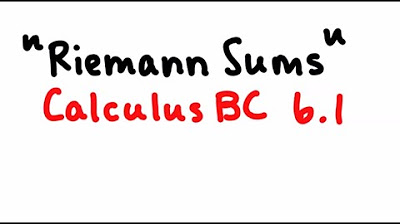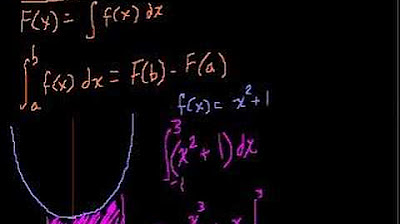Integrating sums of functions | Accumulation and Riemann sums | AP Calculus AB | Khan Academy
TLDRThe video script discusses the concept of definite integrals and their application in calculating the area under the curve of functions. It explains how the area under the curve of a sum of two functions can be found by adding the areas under the individual curves. The script uses the example of functions f(x) and g(x) to illustrate this principle, highlighting the usefulness of decomposing integrals for computation and conceptual understanding.
Takeaways
- 📈 The concept of definite integrals can be used to find the area under a curve between two points a and b.
- 🤔 The integral of a function represents the area under its graph and can be approximated by summing infinitesimal rectangles.
- 🟢 By adding the functions f(x) and g(x), we can obtain a new function h(x) = f(x) + g(x) and its graph represents the combined effect of both functions.
- 📊 The area under the curve of h(x) between a and b can be represented as the definite integral from a to b of (f(x) + g(x)) dx.
- 🔢 The integral of the sum of functions is equal to the sum of the integrals of the individual functions, a principle that simplifies the process of evaluating complex integrals.
- 🎯 The concept of Riemann sums helps in understanding the geometric interpretation of integrals as the limit of summing the areas of rectangles.
- 🧩 When breaking down integrals, it's useful to decompose them into simpler parts that can be evaluated separately, such as ∫(x^2 + sin(x)) dx from 0 to 1 can be broken down into ∫x^2 dx + ∫sin(x) dx.
- 📚 Understanding the properties of definite integrals is crucial for their computation and application in various mathematical and real-world problems.
- 🌟 The ability to decompose and reassemble integrals is a powerful technique that can make the evaluation of complex integrals more manageable.
- 🔍 The process of approximating the graph of a function by adding other functions provides an intuitive understanding of the resulting area under the curve.
- 🛠️ The script illustrates the practical application of integral calculus in solving problems involving the accumulation of quantities over a given interval.
Q & A
What is the basic concept of a definite integral?
-A definite integral represents the area under a curve and above the x-axis between two points on the x-axis, denoted as the interval [a, b]. It is calculated as the limit of the sum of infinitely thin rectangles, each with height equal to the function value at its left endpoint and width equal to the change in x.
How can the area under the curve of a function be represented?
-The area under the curve of a function can be represented as the definite integral of the function from point a to point b, denoted as ∫ from a to b of f(x) dx.
What does the graph of y = f(x) represent?
-The graph of y = f(x) represents the set of all points (x, f(x)) where x is in the domain of the function f and f(x) is the corresponding function value. It is a visual representation of the function's behavior.
What is the significance of the sum of two functions in the context of definite integrals?
-The sum of two functions, f(x) + g(x), is significant in the context of definite integrals because it allows us to break down and simplify complex integrals into more manageable parts, potentially making them easier to compute or conceptualize.
How does the area under the curve of the sum of two functions relate to the individual areas under their curves?
-The area under the curve of the sum of two functions (f(x) + g(x)) is equal to the sum of the individual areas under their curves, which can be expressed as ∫ from a to b of (f(x) + g(x)) dx = ∫ from a to b of f(x) dx + ∫ from a to b of g(x) dx.
What is the process of approximating the graph of a function?
-The process of approximating the graph of a function involves making educated guesses about the shape and position of the curve based on the function's behavior and values at specific points. This can be done by plotting points, drawing curves, and using visual estimation.
How does the concept of Riemann sums help in understanding definite integrals?
-Riemann sums provide a way to think about definite integrals by considering the area under a curve as the sum of rectangles with infinitesimal widths. The height of each rectangle is the function value at a specific point, and as the width approaches zero, the sum of these rectangles approaches the area under the curve.
What is the relationship between the definite integral of a function and its antiderivative?
-The definite integral of a function is related to its antiderivative (also known as the indefinite integral) through the Fundamental Theorem of Calculus. The definite integral from a to b of f(x) dx is equal to the antiderivative of f(x) evaluated at b minus the antiderivative evaluated at a.
What is the significance of decomposing integrals?
-Decomposing integrals is significant because it allows us to simplify complex integrals by breaking them down into parts that may be easier to compute or understand. This can greatly simplify the process of evaluating integrals and is a powerful tool in calculus.
How does the concept of definite integrals relate to the concept of summation?
-The concept of definite integrals is closely related to summation in that both involve adding up values. In the case of definite integrals, we are summing up infinitesimally small 'rectangles' to find the area under a curve, which is analogous to summing a sequence of numbers to find its total.
What is the role of intuition in understanding definite integrals?
-Intuition plays a crucial role in understanding definite integrals as it helps in visualizing the area under a curve and the process of summing up infinitesimally small rectangles. It provides a conceptual framework that aids in the comprehension of the mathematical concepts and the steps involved in evaluating integrals.
Outlines
📊 Understanding Definite Integrals and Area Calculation
This paragraph introduces the concept of definite integrals and their application in calculating the area under a curve. It explains how the area between the curve y=f(x) and the x-axis from points a to b can be represented as the definite integral of f(x) with respect to x from a to b. The paragraph also discusses the idea of approximating the graph of a function that is the sum of two functions, f(x) + g(x), by visually adding the values of g(x) to the corresponding points on the graph of f(x). The key takeaway is that the area under the combined curve can be found by summing the areas under each individual curve, providing an intuitive understanding of the integral's geometric interpretation.
🔢 Decomposition of Integrals and its Utility
The second paragraph delves into the practical application of decomposing integrals for easier computation and conceptual understanding. It emphasizes the importance of recognizing that the area under the curve of the sum of two functions, f(x) + g(x), can be represented as the sum of the areas under the individual curves. The paragraph illustrates this by likening the process to summing the heights of infinitely thin rectangles, which remain consistent even when shifted vertically by the function f(x). This decomposition is highlighted as a powerful principle in integral calculus, allowing for the simplification of complex integrals by breaking them down into more manageable parts. The discussion concludes by hinting at the utility of this approach in future studies of integral evaluation, where such decomposition can significantly streamline the process.
Mindmap
Keywords
💡Functions
💡Graphs
💡Definite Integral
💡Area
💡Sum of Functions
💡Approximation
💡Riemann Sums
💡Curve
💡Positive X Axis
💡Computation
💡Conceptualization
Highlights
The concept of definite integrals and their representation of areas under curves is introduced.
The method of approximating the graph of a function by summing areas under the curve is explained.
The process of calculating the area between the curve y=f(x) and the x-axis from x=a to x=b using definite integrals is described.
The idea of representing the area under the curve y=g(x) in a similar manner to y=f(x) is presented.
The concept of adding functions to create a new function, and its impact on the resulting curve, is explored.
An intuitive approach to understanding the sum of functions and their integrals is discussed.
The process of approximating the graph of y=f(x)+g(x) by adding values of g(x) to the graph of f(x) is detailed.
The relationship between the area under the curve of a sum of functions and the individual areas under their respective curves is examined.
The integral of the sum of functions is shown to be equivalent to the sum of the individual integrals, providing a powerful principle for computation.
The practical application of breaking down complex integrals into simpler parts is highlighted.
The transcript emphasizes the importance of understanding the geometric interpretation of integrals.
The transcript introduces the concept of Riemann sums and their role in approximating integrals.
The significance of the height of rectangles in the Riemann sum approximation is discussed.
The transcript explains how the addition of functions affects the height of the rectangles used in the Riemann sum.
The transcript provides an intuitive understanding of how the integral of a sum of functions relates to the integrals of the individual functions.
The transcript concludes by emphasizing the usefulness of decomposing integrals for computation and conceptual understanding.
Transcripts
Browse More Related Video

Functions defined by definite integrals (accumulation functions) | AP Calculus AB | Khan Academy

Fundamental theorem of calculus (Part 2) | AP Calculus AB | Khan Academy

Riemann Sums

Definite Integrals!

Area between curves | Applications of definite integrals | AP Calculus AB | Khan Academy

Definite Integrals (part 4)
5.0 / 5 (0 votes)
Thanks for rating: